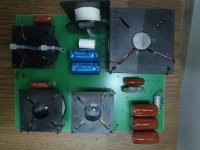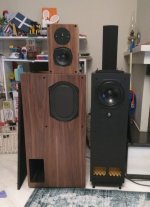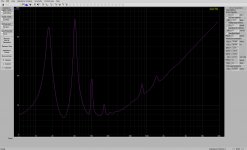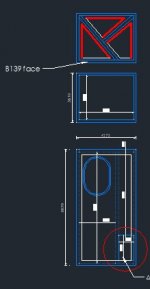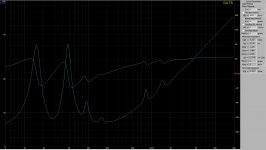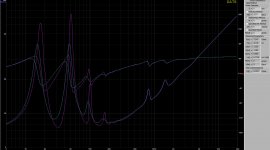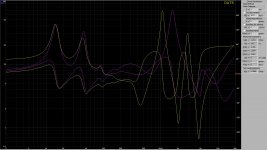To make them sing, build the Cambridge R50 crossover and add the Coles 23ohm super tweeter.
TO make them sing i would pull everything above the bass driver out, replace with a good small full-range (FF85wk or A5.2) and bi-amp. But the midTweeter encclosure in this box might be tricky.
The T27 is not overly extended.
dave
Oh I did realise that you have the B110 & T27 in a different enclosure. I'd be putting them in the same enclosure.
I'm kind of aware of the problems that may rise due to the M-T satellite but the reason is that I already had the boxes (from the CS1 kit) and I wanted to use them either on top or at the side on floor stands that will bring them on the same height as the B139. I will test and if problems risen seriously affect reproduction I will place them on the same enclosure.
As already mentioned, the proposed Radford crossover sounds terrible. I can try the changes proposed by chevelosm but since I have the equipment I would like to try and build a crossover that will fit my design. Well at least I can try... I can go passive but since I have enough Rotel power amps I can try tri-amping (maybe with minidsp or another electronic crossover).
But before I decide on whether I go passive or active, I want to fill the box with the damping material. And at this point I would really appreciate your help an a starting point! Bailey proposed stuffing with lamb's wool. I have a lot of labs wool that I got from qtasystems but I find the process of combing tedious and time consuming. I recently got 10 packs of Visaton lamb's wool for a reasonable price and I'm thinking of using this instead. It is a ~3cm thick lamb's wool - acrylic stuff (I think 85%-15% ratio) which comes in 33cmx60cm pads. I have obtained the impedance curves from the B139's installed on the boxes using the DATS v2 system (see attached thumbnails). I have already lined the back of the wall (behind the B139) with a piece of 1cm wool felt. I'm thinking as a starting point to line the walls as shown on the third thumbnail (plan view of box - red lines indicate the lining) and then make some measurements. What do you think? Is it a good starting point or should I stick to the Bailey approach? Also, I have lined the sides, back, top and bottom with 5cm thick sound absorbing material (https://www.lazarakis.gr/images/eshop/catalog/products/1644/files/SOUNDBAR (2008.09).pdf). The link is in Greek but you can get the general idea from the graphs.
As already mentioned, the proposed Radford crossover sounds terrible. I can try the changes proposed by chevelosm but since I have the equipment I would like to try and build a crossover that will fit my design. Well at least I can try... I can go passive but since I have enough Rotel power amps I can try tri-amping (maybe with minidsp or another electronic crossover).
But before I decide on whether I go passive or active, I want to fill the box with the damping material. And at this point I would really appreciate your help an a starting point! Bailey proposed stuffing with lamb's wool. I have a lot of labs wool that I got from qtasystems but I find the process of combing tedious and time consuming. I recently got 10 packs of Visaton lamb's wool for a reasonable price and I'm thinking of using this instead. It is a ~3cm thick lamb's wool - acrylic stuff (I think 85%-15% ratio) which comes in 33cmx60cm pads. I have obtained the impedance curves from the B139's installed on the boxes using the DATS v2 system (see attached thumbnails). I have already lined the back of the wall (behind the B139) with a piece of 1cm wool felt. I'm thinking as a starting point to line the walls as shown on the third thumbnail (plan view of box - red lines indicate the lining) and then make some measurements. What do you think? Is it a good starting point or should I stick to the Bailey approach? Also, I have lined the sides, back, top and bottom with 5cm thick sound absorbing material (https://www.lazarakis.gr/images/eshop/catalog/products/1644/files/SOUNDBAR (2008.09).pdf). The link is in Greek but you can get the general idea from the graphs.
Attachments
Update: The following impedance curve was taken after applying Visaton Lamb's Wool on the upper, lower and side walls of the box (green line is after damping, purple before). No change in spikes at ~800Hz and ~1600Hz. Any suggestions? Shall I go on with lining the partitions as well or try filling with poly-fill or lamb's wool?
Attachments
The graph clearly shows the effect of the damping. It should be more effective at higher frequencies, so the 800/2x800 Hz resonance issue is not (at all likely) to be anything acoustic. It is either a panel resonance or a driver resonance, unlikely to from the XO.
Have you got an impedance curve of the bass driver without any XO? Mid?
dave
Have you got an impedance curve of the bass driver without any XO? Mid?
dave
Good morning Dave,
These curves were derived with no crossover at all, only bass driver. Below are the impedance measurement with DN12 (purple color) and the proposed Radford crossover (yellow color) that I got this morning. The 800/2x800 are most certainly from the driver (see also the curves from user gpapag here, he uses the same box: KEF B139b sp1044)). To me it looks like I have to deal with the two spikes at 90/160 Hz.
These curves were derived with no crossover at all, only bass driver. Below are the impedance measurement with DN12 (purple color) and the proposed Radford crossover (yellow color) that I got this morning. The 800/2x800 are most certainly from the driver (see also the curves from user gpapag here, he uses the same box: KEF B139b sp1044)). To me it looks like I have to deal with the two spikes at 90/160 Hz.
Attachments
I have to deal with the two spikes at 90/160 Hz
The 90 is the 1st unwanted harmonic. Usually killed by using a very specific driver offset… in the old days it was dealt with by adding more damping, but that also affects the fundemental meaning less low bass.
dave
That's why I will use Hornsrep or Leonard Audio TL for my next project. Or when I'm bored with the Bailey box I might go for this one: http://p10hifi.net/TLS/downloads/PushPush-B139-TL-map-041107.pdf (plus a very-very nice gift for my wife...)
I will try to reduce this 1st harmonic by stuffing behind the driver (?).
I will try to reduce this 1st harmonic by stuffing behind the driver (?).
I will try to reduce this 1st harmonic by stuffing behind the driver (?).
The lower in frequency the harmonic the more of the line needs filling. To combat the lowest one you need to damp the entire line (volume fill), with perhaps greater density at the high pressure node of that wavelength.
dave
- Status
- Not open for further replies.
- Home
- Loudspeakers
- Multi-Way
- Need Advise - Radford Crossover Inductors
